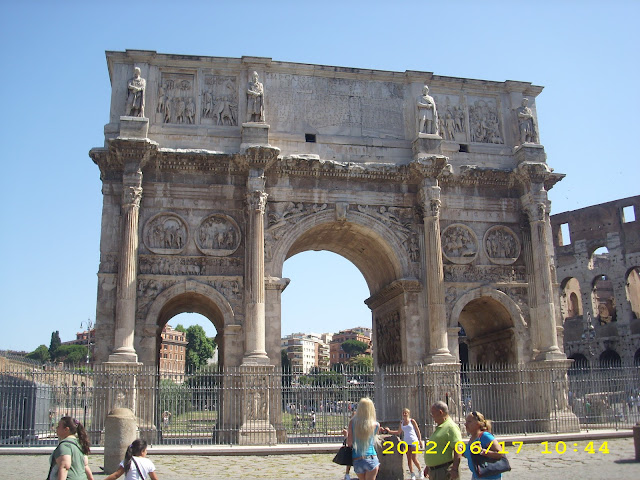 The Arch of Constantine was built in 315 A.D to commemorate Constantine's victory over Mexentius (his co-emperor) at the Battle of Milvian Bridge in 312 A.D. The Battle of Milvian Bridge is the famous battle in Christian history. According to certain Christian historians, Constantine had a vision, before the battle that God would help him win the battle if he would mark a chi-rho symbol on his soldier's shields. Chi (the X shape--pronounced "ki") and rho (the P shape) were the first two letters in "Christ", in Greek, and were often used as a symbol by Christians. So, adding this insignia was seen kind of like marking a cross on their shields.
The Arch of Constantine was built in 315 A.D to commemorate Constantine's victory over Mexentius (his co-emperor) at the Battle of Milvian Bridge in 312 A.D. The Battle of Milvian Bridge is the famous battle in Christian history. According to certain Christian historians, Constantine had a vision, before the battle that God would help him win the battle if he would mark a chi-rho symbol on his soldier's shields. Chi (the X shape--pronounced "ki") and rho (the P shape) were the first two letters in "Christ", in Greek, and were often used as a symbol by Christians. So, adding this insignia was seen kind of like marking a cross on their shields.  |
| The Battle of the Milvian Bridge (1520–24) by Giulio Romano, which is in the Vatican. |
The Arch of Constantine stands right next to the Colosseum and is about 70 feet high!
You can't go right up to the Arch because it has a large fence around it. A lot of the Roman ruins have problems with people stealing chunks of rocks or statues, so I think that the fence is there to protect the Arch. It seems to lose a little bit of its impact, since you can't walk under it and get a real sense of its size. In ancient times, you probably would have had to walk through the Archway, depending on where you were going in the city.
 |
| The Arch of Constantine is on the left and the Forum buildings are in the background. |
This is a SmartHistory video on the Arch of Constantine. It is a bit long, and you may have to listen carefully to understand the Italian professor, but I think that it is really worthwhile. She explains the historical background and conflicts behind the building of the Arc, the art, what the various pictures or statutes mean, the how the Arc was designed--including some really dramatic plagiarism (or just outright theft). It really is fascinating.














































